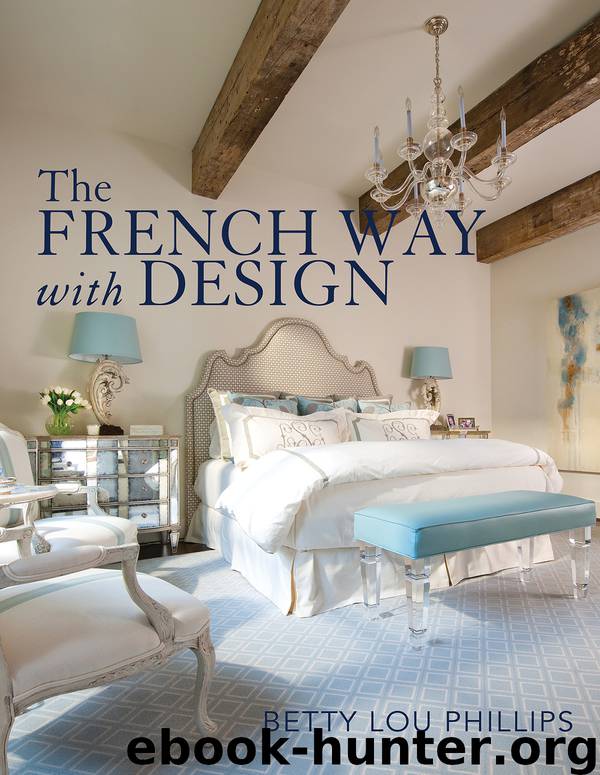The French Way with Design by Betty Lou Phillips

Author:Betty Lou Phillips
Language: eng
Format: epub
Publisher: Gibbs Smith
Published: 2014-09-09T16:00:00+00:00
Time-Honored Textiles
In the French material world, fabrics, furniture, floor coverings and objets d’art vie with one another for the pleasure of introducing color to a room. But it’s most often compelling fabrics that set the mood, whether the starting point or not.
Old-world fabrics, such as those from the grand house of Braquenié—one of the preferred textile lines—rise to the occasion, tempering the stuffiness of oak-paneled boiserie, while casting parquet de Versailles floors and antique urns turned into lamps in a new light with help, certainly, from a gamut of stylish shades. Without fail, exquisite silks, jacquards and damasks woven in France’s fabled textile mills hidden outside Lyon also win considerable applause.
Fiber—either natural or synthetic—is the origin of all fabrics. Natural fibers woven from tufts of plants or animals produce cotton, linen, wool and silk. Polyester, nylon, acrylic, rayon and acetate emerge from laboratory-made synthetic fibers. Synthetics are stronger and more resistant to fading and wrinkling than pure fibers, but they are sullied by a tendency to droop and pill—and perhaps the fact that they are lower priced.
For more than two millenniums, the Chinese zealously guarded secrets surrounding the production of silk, making smuggling silkworms out of China a crime punishable by death. As if leaving nothing to chance, a law also prohibited commoners from donning the fabric, as it was strictly the province of emperors and royalty. Following Marco Polo’s journey along the famed Silk Road, the trade route that stretched from China through Central Asia to the Mediterranean Sea, silk mania gripped France, with people clothing themselves, embellishing their homes and treating silk somewhat reverentially. When it comes to selecting fabrics, it might help to think French.
F Luxurious silk, whose radiance rivals precious gemstones, communicates a subtle elegance that complements deep moldings and elegantly carved boiserie glazed light gray, gray-green or gray-blue. It is more grounded than historically opulent brocade woven with metallic threads, or its equally chic cousins satin and jacquard. The latter’s elaborately woven pattern is produced on a loom with the same name, invented in 1801 by French weaver Joseph Marie Jacquard.
F Velvet lends a soupçon of grandeur to any setting, defining what it means to be fashion-forward without being overly bold. Long associated with wealth, power and the monarchy, its sumptuous pile absorbs color, whether a solid, stripe, pattern or made of wool, silk, linen, cotton, nylon or a blend. Thanks to anti-crease technology, the newest velvets are resistant to unsightly marks and folds.
F Linen suggests a relaxed mode while projecting a more upscale image than cotton, perhaps the result of its higher price point, attributed in part to its being famously long-lasting. (In 1923, when King Tutankhamen’s tomb was opened, the linen curtains were intact.) But its celebrated durability aside, flax fibers lack elasticity, making the weaving of linen a difficult process. And though the fabric does wrinkle easily, few view this as a downside. (Knit backing can help stabilize or prevent a fabric from stretching if used on upholstery.) Knots and slubs are characteristic of lesser quality linen.
Download
This site does not store any files on its server. We only index and link to content provided by other sites. Please contact the content providers to delete copyright contents if any and email us, we'll remove relevant links or contents immediately.
| Decorative Arts | Design History & Criticism |
| Furniture Design | Industrial & Product Design |
| Interior & Home Design | Jewelry Design |
| Textile & Costume |
POP by Steven Heller(3297)
Japanese Design by Patricia J. Graham(3097)
The Power of Broke by Daymond John(2877)
Architecture 101 by Nicole Bridge(2745)
Indistractable: How to Control Your Attention and Choose Your Life by Nir Eyal(2319)
Fusion 360 for Makers by Lydia Sloan Cline(2294)
Batik by Rudolf Smend(2111)
Actionable Gamification: Beyond Points, Badges, and Leaderboards by Yu-kai Chou(2111)
Origami Art by Michael G. Lafosse & Richard L. Alexander(2052)
Homebody by Joanna Gaines(2021)
Whiskey in a Teacup by Reese Witherspoon(1922)
Worn in New York by Emily Spivack(1917)
Feng Shui by Stephen Skinner(1889)
Austin Kleon by Steal Like an Artist(1871)
Simple Gatherings by Melissa Michaels(1838)
Don't Make Me Think, Revisited: A Common Sense Approach to Web Usability by Steve Krug(1813)
Hygge: The Danish Art of Happiness by Marie Tourell Søderberg(1682)
The Joy of Hygge by Jonny Jackson(1670)
The Laws of Simplicity by John Maeda(1556)
